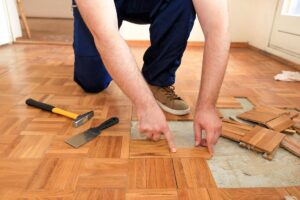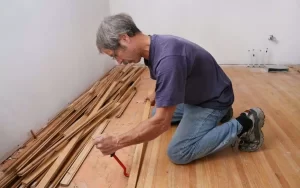Are you wondering if it’s time to remove that old flooring? Well, we’ve got you covered! In this article, we’ll explore the reasons why removing old flooring might be a smart move.

We’ll also discuss the signs that indicate it’s time for a change and the benefits of doing so before installing new flooring. Plus, we’ll provide a step-by-step guide and share common mistakes to avoid.
So, let’s dive in and discover if removing old flooring is the right choice for you.
Key Takeaways of Should You Remove Old Flooring
- Removing old flooring allows for a thorough assessment of the condition of the subfloor underneath.
- It improves the overall aesthetic of the space and ensures a safer environment.
- Environmentally-friendly disposal options such as recycling or repurposing materials can be chosen.
- Removing old flooring before installing new flooring results in improved installation quality, enhanced durability, and better indoor air quality.
Reasons to Consider Removing Old Flooring
There are several reasons why you should consider removing old flooring.
The removal process can be a hassle, but it is worth it for a number of reasons.
Firstly, old flooring can become worn and damaged over time, leading to an unappealing appearance and potential safety hazards. By removing the old flooring, you can improve the overall aesthetic of your space and ensure a safer environment.

Additionally, removing old flooring allows you to assess the condition of the subfloor underneath. This is important because any underlying issues can be addressed before installing new flooring.
Lastly, when considering disposal options for old flooring, it is essential to choose environmentally-friendly methods such as recycling or repurposing materials whenever possible.
Signs That Indicate It’s Time to Remove Old Flooring
If your floors are showing signs of wear and tear, it’s time to consider removing them. Deteriorating flooring not only looks unsightly but can also pose safety hazards. Here are some signs that indicate it’s time to remove old flooring:
| Signs of Deteriorating Flooring | Reasons for Removal |
|---|---|
| Cracks or chips | Potential trip hazards |
| Stains or discoloration | Difficult to clean and maintain |
| Warping or buckling | Structural damage risk |
| Persistent odors | Mold or mildew growth risk |
Cracks or chips in the flooring can create potential trip hazards, especially if they’re in high-traffic areas. Stains and discoloration not only make your floors look dirty but can also be difficult to clean and maintain. Warping or buckling indicates structural damage, which may require immediate attention to prevent further issues. Persistent odors could be a sign of mold or mildew growth, making it necessary to remove the old flooring for health reasons.
Benefits of Removing Old Flooring Before Installing New
When it comes to installing new flooring, removing the old flooring beforehand can offer several key benefits.
First and foremost, it leads to improved installation quality as the new flooring can be installed on a clean and level surface.
Additionally, removing old flooring enhances durability and longevity by ensuring that any underlying issues or damage are addressed before the new flooring is laid down.
Lastly, removing old flooring promotes better indoor air quality by eliminating trapped allergens, dust, and potentially harmful substances that may have accumulated over time.
Improved Installation Quality
The improved installation quality ensures a more durable and long-lasting flooring.
With improved installation techniques, the new flooring is laid down evenly and securely, eliminating any potential gaps or unevenness.
The use of advanced adhesives ensures that the flooring stays firmly in place, even under heavy foot traffic or furniture movement.
Precise cutting and fitting techniques result in seamless transitions between different sections of the flooring, creating a polished and professional look.

Proper preparation of the subfloor, including cleaning and leveling, prevents any future issues such as squeaking or warping.
These improvements not only enhance the overall aesthetic appeal of your home but also have a positive impact on its value.
A well-installed flooring adds to the perceived quality and desirability of a property, making it more attractive to potential buyers in the future.
Enhanced Durability and Longevity
By using advanced installation techniques and high-quality materials, the new flooring is designed to last for many years. Our team ensures enhanced durability by carefully preparing the subfloor, removing any imperfections or debris that could affect the longevity of the new flooring.
We also use underlayment materials that provide additional support and protection against moisture or potential damage. The high-quality materials we use are specifically chosen for their strength and resistance to wear and tear. This not only increases the durability of the flooring but also improves its overall aesthetics.
With our expertise in installation, we ensure a seamless finish that enhances the visual appeal of your space while providing long-lasting performance. Whether it’s hardwood, laminate, vinyl, or tile, our commitment to using top-notch materials and techniques guarantees a robust and beautiful floor that will withstand daily use for years to come.
Better Indoor Air Quality
Using high-quality materials and proper ventilation, our team ensures that the new flooring contributes to better indoor air quality. Here are four ways in which our approach leads to improved health and respiratory benefits:
- Sealing: We carefully seal all gaps and cracks to prevent dust, pollen, and other allergens from entering the living spaces.
- Low VOCs: Our flooring options are low in volatile organic compounds (VOCs), reducing the release of harmful chemicals into the air.
- Mold resistance: The materials we use are resistant to moisture, inhibiting mold growth and preventing potential respiratory issues.
- Easy maintenance: With our flooring solutions, cleaning becomes a breeze, minimizing the accumulation of dust and dirt that can trigger allergies.
By prioritizing better indoor air quality through these measures, we ensure a healthier environment for you and your family.
However, before removing old flooring, there are several factors to consider.
Factors to Consider Before Removing Old Flooring
Before removing old flooring, there are several factors that should be considered.
First and foremost is the cost of replacement. It is important to evaluate whether the expense of removing and replacing the old flooring outweighs the benefits.
Additionally, the condition of the subfloor must be taken into account as it can impact the installation process and overall durability of the new flooring.

Lastly, one should consider their desired new flooring and whether it is compatible with or requires removal of the existing floor for a seamless and satisfactory result.
Cost of Replacement
Is it worth the cost to replace your old flooring? Let’s do a cost analysis and consider some DIY options.
- Labor: Hiring professionals can be expensive, but doing it yourself requires time, effort, and skill.
- Materials: The cost of new flooring varies depending on the type and quality you choose.
- Removal: Removing old flooring can be labor-intensive and may require specialized tools.
- Installation: Installing new flooring correctly is crucial for its longevity and appearance.
Considering these factors, the cost of replacing your old flooring can range from a few hundred dollars to several thousand.
DIY options may save money upfront, but mistakes could end up costing more in the long run if professional intervention is needed. It’s important to weigh the costs against your budget and personal capabilities before making a decision.
Condition of Subfloor
The condition of the subfloor determines the stability and durability of your new flooring. Proper subfloor preparation is essential to ensure a solid foundation for your desired new flooring.
Before installing any new flooring, it’s important to assess the condition of the subfloor. If there are any signs of damage or unevenness, subfloor repair may be necessary. This could involve fixing any cracks, leveling uneven areas, or replacing damaged sections of the subfloor. Subfloor repairs should be done meticulously to prevent future problems with your new flooring.
By addressing any issues with the subfloor beforehand, you can ensure that your desired new flooring will have a long-lasting and durable installation.
Now that we understand the importance of a sound subfloor, let’s explore various options for your desired new flooring.
Desired New Flooring
Now that we have assessed the condition of the subfloor, let’s move on to discussing the desired new flooring options.
When it comes to choosing a new floor, there are numerous options available, each with their own set of pros and cons. Here are four popular types of flooring and what you need to know about them:
- Hardwood: This timeless choice offers durability and beauty but can be expensive and requires regular maintenance.
- Laminate: A cost-effective alternative to hardwood, laminate mimics its appearance but may not be as long-lasting.
- Carpet: Soft and cozy underfoot, carpet is great for bedrooms but can trap allergens and stains easily.
- Tile: Durable and easy to clean, tile is ideal for high-traffic areas; however, it can be cold and hard.
Considering your lifestyle, budget, and personal preferences will help you make an informed decision regarding your desired new flooring.
Step-by-Step Guide to Removing Old Flooring
First, you’ll want to gather the necessary tools for removing old flooring. This step is crucial to ensure a smooth and efficient process. Here’s a table that outlines the pros and cons of DIY flooring removal versus hiring professionals:
| Pros of DIY Flooring Removal | Cons of DIY Flooring Removal | Hiring Professionals for Flooring Removal |
|---|---|---|
| Cost-effective | Time-consuming | Expertise and experience |
| Sense of accomplishment | Risk of damaging subfloor | Efficiency and speed |
| Flexibility in scheduling | Physically demanding | Professional equipment |
When considering whether to tackle the job yourself or hire professionals, it’s important to weigh these factors. DIY flooring removal can save money and provide a sense of achievement, but it requires time, physical effort, and carries the risk of damaging your subfloor. On the other hand, hiring professionals offers expertise, efficiency, and professional equipment at an additional cost. Ultimately, your decision should be based on your skills, available time, budget, and desired outcome.
Common Mistakes to Avoid When Removing Old Flooring
To prevent unnecessary damage and ensure a smooth process, it’s crucial to avoid these common mistakes when taking out your old flooring. Here are four tips for a smooth flooring removal process:
- Not wearing protective gear: It’s important to wear safety goggles, gloves, and a dust mask to protect yourself from any potential hazards such as flying debris or harmful chemicals.
- Using improper tools: Using the wrong tools can not only make the job harder but also cause damage to the subfloor or surrounding areas. Make sure you have the right tools such as pry bars, utility knives, and floor scrapers.
- Rushing the process: Removing old flooring requires patience and careful attention to detail. Rushing through it can lead to uneven surfaces or even accidents. Take your time and work methodically.
- Neglecting proper disposal: Dispose of old flooring materials responsibly by following local regulations or hiring professionals for safe disposal. Improper disposal may harm the environment or result in fines.
Alternatives to Removing Old Flooring
If you’re looking for alternatives, consider options like refinishing or covering up your existing flooring.
These alternative flooring options can be a great solution for those who want to avoid the hassle and expense of removing old flooring.
Refinishing involves sanding down the existing floor and applying a new finish to give it a fresh look. This option is ideal for hardwood floors that are still in good condition but need a little TLC.
On the other hand, covering up your old flooring with new materials like carpet or vinyl can provide a quick and easy makeover. However, it’s important to weigh the pros and cons of keeping old flooring before deciding on these alternatives.
While it may be cost-effective and time-saving, old flooring may have issues such as wear and tear, damage, or an outdated style that could affect the overall aesthetic of your space.
Frequently Asked Questions
How Much Does It Typically Cost to Remove Old Flooring?
Removing old flooring can vary in cost depending on factors such as the type of flooring, square footage, and location. Cost considerations include disposal fees and potential repairs. DIY options are cheaper, but professional services ensure proper removal and minimize potential issues.
Can Old Flooring Be Recycled or Repurposed?
Old flooring can be recycled or repurposed, offering numerous benefits. Recycling reduces waste and conserves resources, while creative upcycling ideas give new life to old materials. It’s an environmentally-friendly choice that adds a unique touch to any space.
What Are the Potential Health Risks Associated With Removing Old Flooring?
Potential respiratory problems and exposure to harmful chemicals are two health risks associated with removing old flooring. It is important to take precautions such as wearing protective gear and ensuring proper ventilation during the process.
Are There Any Eco-Friendly Options for Removing Old Flooring?
There are several eco-friendly disposal methods available when removing old flooring. In addition, there are alternative flooring options that are more sustainable and environmentally friendly.
How Long Does It Usually Take to Remove Old Flooring?
When removing old flooring, the timeframe and tools needed depend on various factors such as the type of flooring, its condition, and the size of the area. It’s important to assess these factors before beginning the process.
Conclusion
In conclusion, removing old flooring before installing new can be a wise decision for several reasons.
While it may seem like an additional step, the benefits far outweigh the effort involved. By removing old flooring, you eliminate any potential issues that may arise in the future and ensure a smooth installation process.
Although some may argue that it is unnecessary and time-consuming, think of it as a fresh start – like peeling away layers to reveal a beautiful new surface waiting to be unveiled.
Take the time to remove old flooring and you’ll be rewarded with a stunning transformation in your space.




